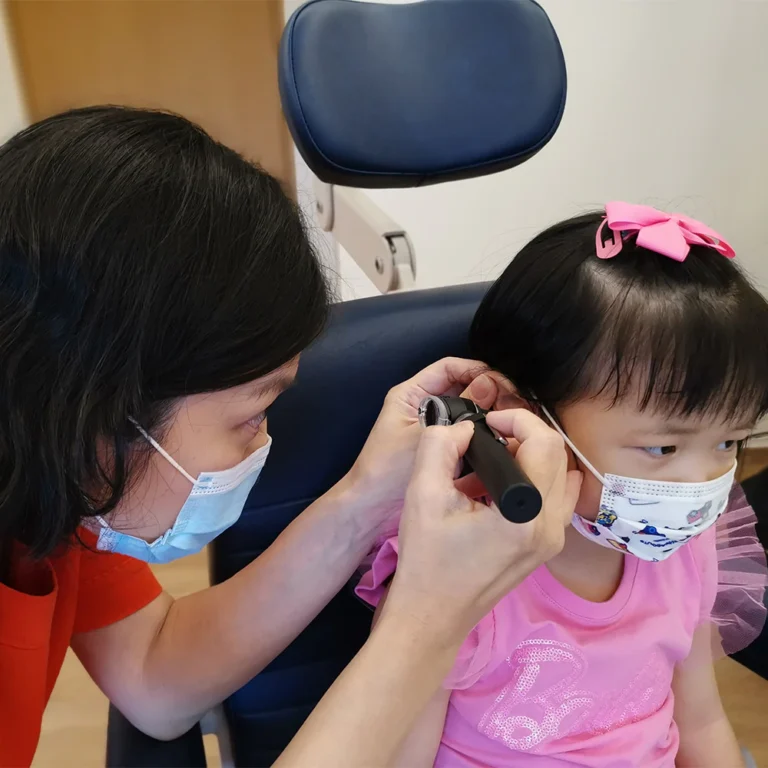Ear wax might seem insignificant, but when it accumulates, especially in children, it can lead to more problems than many parents realise. Excessive ear wax, or cerumen impaction, is a surprisingly common issue among kids and can result in various complications, including discomfort, hearing issues, and even delays in speech development. If your child has been pulling at their ears, expressing ear pain, or if you’ve noticed changes in their hearing or behaviour, a build-up of earwax could be the culprit.
In most cases, it can be easily treated with the assistance of an ENT specialist. But what does this build-up mean for your child’s health, and how can you tell when it’s time to seek professional help?
Why Do Children Experience Ear Wax Build-Up?
Ear wax is a natural substance produced by our bodies to protect the ear canal from dust, debris, and bacteria. It serves as a barrier, preventing harmful particles from reaching the sensitive areas of the inner ear. Typically, ear wax naturally works out of the ear, aided by regular movements like chewing or talking. However, there are instances when ear wax can accumulate instead of being expelled.
Children are particularly susceptible to this because their ear canals are smaller, making it easier for wax to become impacted. Factors such as excessive wax production, the use of cotton swabs, or even the insertion of small objects into the ears can also lead to blockages.
How Ear Wax Build-Up Affects a Child’s Hearing and Development
When ear wax becomes impacted, it can lead to temporary hearing loss, which is particularly concerning for young children. Since hearing is essential for a child’s speech and language development, even mild hearing loss from ear wax build-up can hinder their ability to learn new words, follow instructions, and interact with their surroundings.
1. Hearing Loss and Miscommunication
When excess wax blocks the ear canal, sound cannot reach the eardrum effectively. This blockage can result in a muffled hearing, causing your child to frequently ask for things to be repeated or appear less engaged when spoken to. Children experiencing hearing loss due to earwax may also exhibit signs of frustration or withdrawal from conversations.
2. Speech Development Delays
Hearing is crucial for learning to speak. If a child cannot hear sounds clearly, they may find it difficult to imitate words, develop proper speech patterns, or grasp phonetics. Over time, this can lead to speech delays, which has an impact on their social skills and academic performance.
3. Balance and Comfort Issues
Excessive ear wax can also lead to discomfort, such as itching, a sensation of fullness in the ear, or even dizziness. Since the ear is involved in maintaining balance, a build-up of wax can sometimes result in coordination issues, making children feel unsteady or experience vertigo-like symptoms. While these occurrences are uncommon, they demonstrate that ear wax can affect more than just hearing.
Signs Your Child May Have Excessive Ear Wax
How can you tell if your child is dealing with an ear wax issue? Here are some common indicators:
- Complaints of ear pain or discomfort: Your child might frequently rub or pull at their ears.
- Difficulty hearing: They may not respond when you call them or seem to struggle with understanding conversations.
- Behavioural changes: You might notice increased irritability or frustration, particularly in noisy settings.
- Ear fullness or pressure: Your child could describe their ears as feeling “clogged” or “blocked.”
- Balance issues: Some children may show unsteadiness or have coordination difficulties.
If you observe any of these signs, especially if they continue, it’s wise to consult an ENT specialist to determine if ear wax build-up is the issue.
What ENT Specialists Can Do
While some parents might consider treating ear wax build-up at home with cotton swabs, ear candles, or over-the-counter drops, it’s crucial to avoid these methods as they can push the wax further into the ear canal or cause harm. Instead, ENT specialists (Ear, Nose, and Throat doctors) are trained to safely and effectively remove excess ear wax, particularly in children.
1. Examination and Diagnosis
The first step an ENT specialist will take is to examine your child’s ears with a special tool called an otoscope. This helps them see if earwax is causing a blockage and decide on the best approach.
2. Safe Wax Removal
- ENT specialists employ various safe techniques to remove ear wax, including:
- Microsuction: A gentle suction device is used to extract the wax without harming the ear canal or eardrum.
- Irrigation: Warm water is flushed into the ear canal to dislodge and remove the wax.
- Curettage: In some instances, the ENT may use a small, curved tool to scoop out the wax.
Each method is performed with careful attention to ensure your child’s comfort and safety.
3. Preventive Advice
After the ear wax removal, an ENT specialist will offer guidance on how to prevent future build-up. This may include tips on avoiding cotton swabs, keeping water out of the ears during baths, and recognising the early signs of wax accumulation.
How to Prevent Ear Wax Build-Up in the Future
While it’s not always possible to prevent ear wax build-up, there are measures you can take to minimise the risk. Avoid using cotton swabs or other objects to clean your child’s ears, as these can push the wax further into the ear canal. Instead, promote natural cleaning by gently wiping the outer ear with a damp cloth.
It’s also crucial to keep your child’s ears dry, especially after swimming or bathing. Water trapped in the ear canal can lead to wax build-up and discomfort.
When to See an ENT Specialist
If ear wax build-up becomes a frequent issue, it’s essential to schedule regular check-ups with an ENT specialist. Some children may only need occasional treatment, while others might require more consistent monitoring to keep their ears clear and protect their hearing. Early intervention can help prevent long-term problems and support your child’s hearing and speech development.
Takeaway
Ear wax build-up in children is more than just a minor issue. If left untreated, it can impact hearing, speech development, and overall comfort. Thankfully, with the assistance of ENT specialists, wax blockages can be safely removed, and preventive measures can be implemented to avoid future complications.










